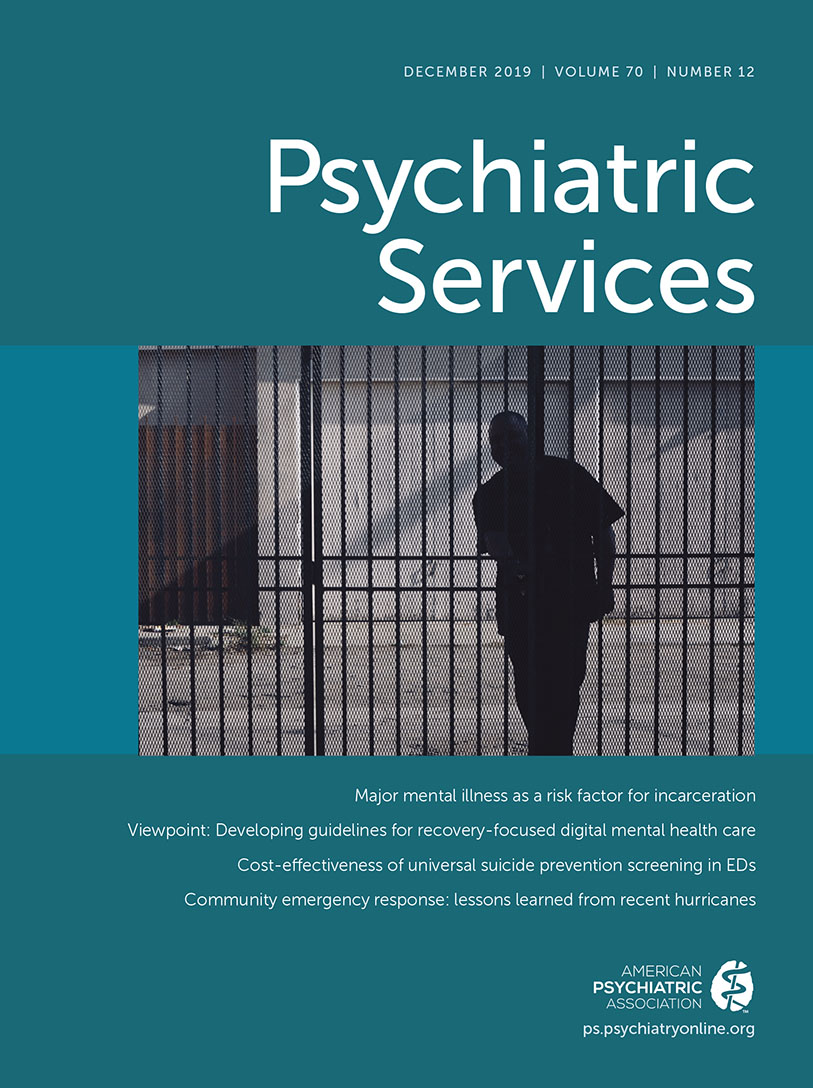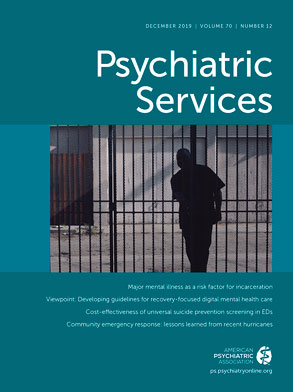Hurricanes are among the most ferocious disaster events, causing widespread destruction and harm to human populations in their path. Populations exposed to these powerful storms sustain physical harm, psychological trauma, massive losses, and life changes (
1). Hurricanes disrupt routines and create psychological distress for patients with preexisting mental disorders. They also produce new-onset psychiatric disorders among previously healthy individuals who are directly exposed to storm hazards and postimpact adversities (
2).
For storm-affected populations, the psychological footprint greatly exceeds the medical footprint. Simply stated, more people are affected psychologically than medically after any given hurricane. This observation is borne out by abundant data collected over several decades. Importantly, global environmental climate change is now making these storms ever more extreme and damaging (
3). Generally, environmental variability appears to produce hurricanes that are stronger, wetter, and slower moving as they pass overpopulated areas (
3,
4). The complex effect of climate change on the behavior of hurricanes carries implications for the mental health and well-being of storm-affected populations. Mobilizing the psychiatric profession to mitigate this growing risk is critical to effective response (
5,
6).
Psychiatric Outcomes Associated With Exposure to Hurricanes
When a hurricane strikes, human populations are subjected to hazards—physical forces of harm. Wind hazards are perhaps best known, but water hazards—including storm surge, coastal wave action, deluging rains, and floods—create the greatest peril (
4). Each storm has a unique hazard profile and generates a singular “trauma signature” (
7).
Climate drivers, which include anomalously warm ocean and air temperatures, influence hurricane formation and behavior. High thermal potential—whereby warm ocean temperatures extend far below the surface—plays a role in sustaining hurricane strength. High atmospheric moisture content can elevate precipitation rates and rainfall totals. Recent North Atlantic hurricane seasons illustrate how climate drivers contribute to the severity of storm hazards and, by extension, to risks for storm-related mental health outcomes.
Consideration of hurricanes’ effects on community mental health must take into account both individuals with preexisting mental disorders and individuals who develop disorders as an outcome of their encounter with the storm. Storms will interrupt the daily routines of persons living with severe mental illness. These individuals will be uprooted during evacuation or sheltering and may experience disruptions of care in a storm’s aftermath. Storm damage, complicated by power outages, may interfere with access to care facilities, providers, and psychiatric medications. As a result, patients’ preexisting psychopathology may be exacerbated, and these individuals may decompensate.
Community mental health systems will be further burdened by new-onset cases of acute psychological distress and emerging psychopathology among previously healthy individuals who experience storm-associated trauma, loss, adversities, and life changes. Direct exposure to hurricane hazards is a well-documented risk for new-onset psychological distress and posttraumatic stress disorder (PTSD), a “disorder of event exposure” (
8).
Significant resource losses and adversities experienced in the aftermath of hurricanes are predictors of major depression, generalized anxiety disorder, and PTSD (
2,
8,
9). Individuals with substance use disorder may increase consumption, or they may relapse if they are in recovery (
5). Recent North Atlantic storms produced high rates of premature mortality (
10); these preventable deaths elevate risks for traumatic bereavement and complicated grief among the surviving family members of those who died.
Lessons Learned From Recent North Atlantic Hurricanes
Hurricane Harvey: stronger, wetter, slower.
In 2017, remnants of Hurricane Harvey revitalized when the storm encountered warm waters in the Gulf of Mexico. Wind speed intensified rapidly to 130 mph prior to making landfall near Corpus Christi, Texas. Thereafter, winds diminished rapidly, but the center of circulation stayed over the Gulf waters. Slowing and stalling over Houston, Harvey produced record-setting rainfall totals and widespread urban flooding.
Psychological stressors for psychopathology were prominent throughout all disaster phases (
11). Preimpact, the storm intensified too rapidly to permit citizens to evacuate or fully prepare. During impact, Harvey deluged Texas residents with 33 trillion gallons of rain, leading to inescapable water rise, entrapment, and widespread inland flooding. Many individuals perceived a threat to their lives as flood waters rose precipitously. Tens of thousands of life-saving water rescues were performed, many improvised by volunteers. Low-income neighborhoods bore the worst of the flooding. In the aftermath, survivors were exposed to heat, humidity, waterborne disease risks, and mold. Many were displaced, and if they lacked flood insurance, many experienced unrecoverable losses of home and possessions.
Hurricane Irma: stronger, longer.
Hurricane Irma, which also struck in 2017, was one of the North Atlantic’s strongest storms. Winds near 180 mph persisted for an unprecedented 37 hours. Irma affected 14 small island developing states (SIDSs), bringing category 4 and 5 winds to eight of them. Irma made landfall multiple times, including in the Florida Keys and on mainland Florida’s coast, and traversed the entire length of Florida’s west coast.
For populations in Irma’s path, risks for psychopathology varied by locale and storm properties throughout the system’s 2-week lifespan. For example, island inhabitants had no option to evacuate; SIDS citizens were directly assaulted by life-threatening winds, projectile debris, storm surge, and pummeling wave action. Irma produced catastrophic damage to buildings. Power outages affected entire island populations.
In contrast to islanders, Floridians had the option to evacuate, but this preventive action proved to be extremely stressful. Many Florida residents drove northward in gridlocked traffic as fuel shortages and road accidents plagued the exodus. Coastal Floridians who tried to move inland (westward), away from Irma’s approach, found themselves in greater danger, because Irma’s center kept moving westward also, prior to turning north. The entire state experienced strong winds and rains, and 15 million Floridians lost power.
Hurricane Maria: stronger, longer, wetter.
Hurricane Maria, another 2017 hurricane, was purely an island storm, bringing tropical storm or hurricane winds to 16 SIDSs. Maria intensified from category 1 to category 5 wind speeds in just 30 hours, prior to decimating Dominica and St. Croix. Maria next made landfall in southeast Puerto Rico and sliced through the territory diagonally, exiting to the northwest. Maria’s pounding rains preceded the winds and continued for a full day after the center of the storm had moved off the island, triggering landslides along the central range that extends the length of the territory.
The aftermath was worse than the impact phase. Multiple SIDSs lost electrical power for months, bringing health care systems and vital infrastructure to a standstill. Mortality analyses conducted in Puerto Rico placed the death toll at 2,975 during the first 6 months after Maria (
10). Many who died were the frail elderly population and persons with chronic medical conditions who were deprived of life-sustaining treatments due to disruption of power and health care services. Puerto Rico’s citizens were subjected to unrelenting heat and humidity and were vulnerable to vector-borne and waterborne diseases. Almost 200,000 residents migrated to the U.S. mainland.
Studies documenting risks for psychopathology during and after Maria are just now being published. For example, 66% of citizens of Punto Santiago, close to the point of landfall, had clinically significant symptoms of depression, anxiety, or PTSD (
12). Comparison samples of Puerto Ricans who stayed versus those who migrated to the U.S. mainland showed very high rates of depression and PTSD in both groups but significantly higher rates for those who relocated (
13). A nationwide survey of 96,000 Puerto Rican students found that 7% had symptoms compatible with PTSD (
14). Furthermore, 45% sustained home damage (25% were displaced), and about one-third perceived personal life threat during the storm.
Hurricanes Florence and Michael: stronger, longer, wetter, slower.
The 2018 hurricane season reprised the preceding year. Hurricane Florence, a storm of extended lifespan, moved across a vast swath of the Atlantic Ocean, reaching category 4 wind speeds. Florence came ashore as a high-category-1 storm, bringing strong surge flooding to eastern North Carolina. Slowing above populated areas, Florence produced devasting freshwater flooding throughout the Carolinas.
In contrast, Hurricane Michael moved swiftly over warm Gulf of Mexico waters, peaking at category 5 strength just as it made catastrophic landfall near the Florida Panhandle, with strong winds and a mammoth storm surge. Among the affected populations were nursing home residents, including many with Alzheimer’s disease.
Climate-Driven Extreme Storms: Ongoing and Emerging Roles for Psychiatrists
Psychiatrists must first prepare themselves and their households for predictable disasters in their home communities. Basic preparations include family disaster planning, stockpiling supplies, decision making regarding evacuation versus sheltering, and devising a family communications plan. Likewise, practice offices, clinics, medical center facilities, and their personnel should be informed and ready. Psychiatrists can educate clinic and academic medical center staff—as well as patients and caregivers—on climate, disaster, preparedness, and mental health risks.
Psychiatrists can play a valuable role by sharing their mental health expertise with local public health and community preparedness partners on how to minimize trauma exposure and maximize coping and resilience, for citizens and responders alike (
15). Psychiatrists can also assist by assuming professional advocacy roles (the American Psychiatric Association’s Climate Psychiatry Caucus regularly creates resource documents and action papers) (
5); producing and promoting evidence-based science, integrating psychiatry with population health and climate science (
16); and personally modeling ecologically sound lifestyles.
Before a storm, psychiatrists can activate their family disaster plans, safeguard loved ones, warn patients to take protective actions, and report for a predetermined response role in a community or health care setting. When a hurricane strikes, and in its aftermath, psychiatrists can provide direct psychiatric services to their patients affected by the storm, to community citizens with new-onset psychopathology due to trauma and loss, and to disaster responders affected by working on scene. In the aftermath, psychiatrists can lead studies that document storm effects on mental health and interventions that work.
Recent Atlantic hurricanes illustrate the compelling need for psychiatrists to prepare and respond to the mental health consequences of increasingly dangerous climate-driven storms affecting their communities.

